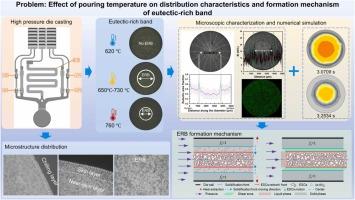Effect of pouring temperature on distribution characteristics and formation mechanism of eutectic-rich band in vacuum-assisted high pressure die casting AlSi9MnMg alloy
IF 7.5
2区 材料科学
Q1 ENGINEERING, INDUSTRIAL
Journal of Materials Processing Technology
Pub Date : 2025-09-12
DOI:10.1016/j.jmatprotec.2025.119066
引用次数: 0
Abstract
The distribution characteristics and formation mechanism of the microstructure in vacuum-assisted high pressure die casting (HPDC) AlSi9MnMg alloy were elucidated by varying pouring temperature. The results show that the casting sample was divided into five distinct regions from the surface to the center, namely the chilling layer, the skin layer, the near-skin layer, the eutectic-rich band, and the core region. Externally solidified crystals (ESCs) play a critical role in the formation of heterogeneous microstructures within the casting. At excessively low pouring temperatures, a large number of ESCs form in the sleeve and enter the die cavity rapidly through the ingate, promoting uniform mixing with the liquid phase. The concentration of ESCs increases the melt viscosity, preventing them from migrating to the center of the casting. Consequently, the solute-rich liquid phase is dispersed within the dendritic network formed by the interconnected ESCs. The eutectic structure is dispersed by the primary α-Al dendrite network, and no distinct eutectic-rich band is formed within the casting. With increasing pouring temperature, the eutectic-rich phenomenon becomes more pronounced, the eutectic-rich band shifts toward the center of the casting. At middle pouring temperatures (650 ℃, 690 ℃, and 730 ℃), an increase in pouring temperature leads to a reduction in the number of ESCs, causing the ESCs dendritic network front to shift closer to the casting center, thereby driving the eutectic-rich band toward the center as well. These conclusions enabled the establishment of the relationship between the spatial distribution of ESCs and eutectic-rich band, thereby revealing the formation mechanism of the eutectic-rich band. This study sheds light on the formation mechanism of eutectic-rich band in HPDC Al-Si alloy and offers guidance for improving HPDC process design, not limited to such alloys.

浇注温度对真空辅助高压压铸AlSi9MnMg合金富共晶带分布特征及形成机制的影响
通过改变浇注温度,研究了真空辅助高压铸造AlSi9MnMg合金组织的分布特征和形成机理。结果表明:铸件试样从表面到中心可划分为5个不同的区域,即冷却层、表皮层、近表皮层、富共晶带和核心区。外部凝固晶体(ESCs)对铸件内部非均相组织的形成起着至关重要的作用。在过低的浇注温度下,大量ESCs在套筒中形成,并通过内浇口迅速进入模腔,促进了与液相的均匀混合。ESCs的浓度增加了熔体粘度,阻止它们向铸件中心迁移。因此,富含溶质的液相分散在由相互连接的ESCs形成的枝晶网络中。共晶组织由初生α-Al枝晶网络分散,铸件内部未形成明显的富共晶带。随着浇注温度的升高,富共晶现象更加明显,富共晶带向铸件中心偏移。在中等浇注温度下(650 ℃、690 ℃和730 ℃),浇注温度的升高导致ESCs数量减少,导致ESCs枝晶网络前沿向浇注中心靠近,从而带动富共晶带向中心移动。这些结论建立了ESCs的空间分布与富共晶带的关系,从而揭示了富共晶带的形成机制。本研究揭示了HPDC Al-Si合金中富共晶带的形成机理,为改进HPDC工艺设计提供指导,而不仅仅局限于这类合金。
本文章由计算机程序翻译,如有差异,请以英文原文为准。
求助全文
约1分钟内获得全文
求助全文
来源期刊

Journal of Materials Processing Technology
工程技术-材料科学:综合
CiteScore
12.60
自引率
4.80%
发文量
403
审稿时长
29 days
期刊介绍:
The Journal of Materials Processing Technology covers the processing techniques used in manufacturing components from metals and other materials. The journal aims to publish full research papers of original, significant and rigorous work and so to contribute to increased production efficiency and improved component performance.
Areas of interest to the journal include:
• Casting, forming and machining
• Additive processing and joining technologies
• The evolution of material properties under the specific conditions met in manufacturing processes
• Surface engineering when it relates specifically to a manufacturing process
• Design and behavior of equipment and tools.
 求助内容:
求助内容: 应助结果提醒方式:
应助结果提醒方式:


